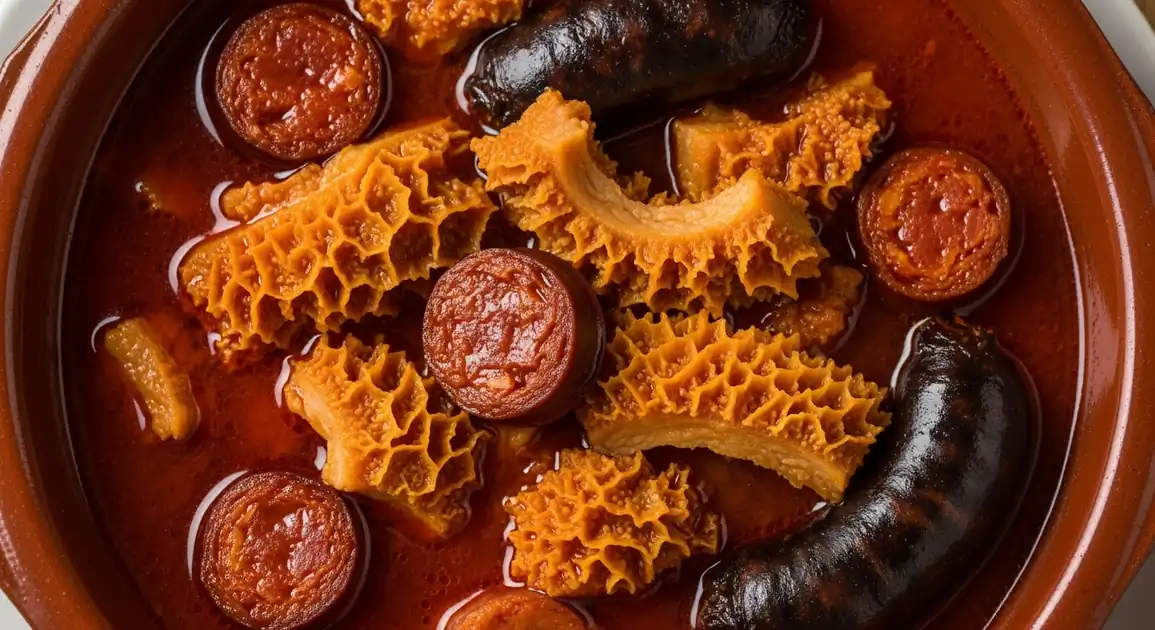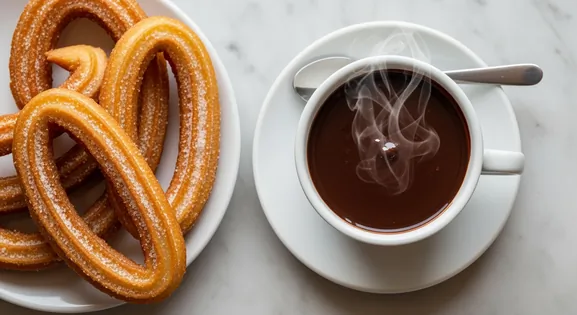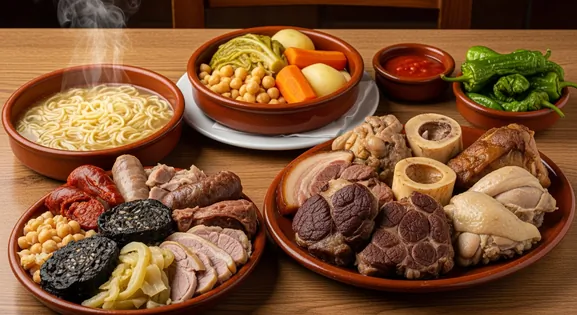Callos (Spanish Tripe Stew) in Madrid
Callos a la Madrileña

The Essential Guide to Callos (Spanish Tripe Stew)
Step into any traditional 'tasca' in Madrid, and you'll likely encounter the comforting aroma of Callos a la Madrileña. This hearty tripe stew, a true Madrileño classic, is more than just a dish; it's a culinary embrace of the city's rich history and robust flavors, perfect for a chilly evening.
New to Callos (Spanish Tripe Stew)? Learn all about its history in our complete guide.
What the Locals Know
While available year-round, Callos is truly best enjoyed during Madrid's cooler months (October-April). The rich, warming stew is the perfect antidote to a crisp Castilian day.
Locals often enjoy Callos with a full-bodied Spanish red wine, like a Ribera del Duero or a good Rioja. The wine's tannins cut through the richness of the dish beautifully.
The most authentic way to eat Callos is to use plenty of crusty bread ('pan') to soak up every last drop of the delicious, paprika-infused sauce. It's an essential part of the experience.
A Traveler's Checklist
What to Look For
-
Served bubbling hot in an earthenware 'cazuela'.
This indicates proper preparation and freshness. Reputable Madrid establishments, especially in areas like La Latina, consistently serve it this way.
-
Rich, thick, reddish broth (from paprika and chorizo).
This visual cue indicates a well-made, slow-cooked stew that has developed its flavors properly. Avoid any broth that appears watery or excessively greasy.
-
Tender, not rubbery, tripe pieces.
The tripe should be incredibly tender, almost melting in your mouth, which is a clear sign of proper, long simmering and expert preparation.
-
Reputable, traditional 'tascas' or restaurants known for 'cocina Madrileña'.
These establishments are dedicated to preserving classic recipes and upholding high standards in their preparation, ensuring an authentic and quality experience.
What to avoid
-
Callos served lukewarm or just warm.
This is a significant red flag for quality. Authentic Callos should always arrive at your table piping hot, indicating it's freshly prepared and ready to be enjoyed.
-
Watery, greasy, or pale broth.
These characteristics suggest shortcuts in preparation or insufficient simmering time, which will compromise the rich flavor and texture of a well-made Callos.
-
Tough, chewy, or rubbery tripe.
This is a clear indicator of undercooking or the use of lower quality ingredients, which will detract significantly from the dish's expected melt-in-your-mouth texture.
-
Establishments with very low prices for the dish or lacking visible quality indicators.
These may suggest compromises in ingredient sourcing or preparation methods, impacting the overall quality and authenticity of the Callos.
The Art of Ordering
When ordering Callos in Madrid, you'll typically find it as a 'ración' (full portion) or sometimes a 'tapa' (small tasting portion) in bars. Don't hesitate to ask if it's 'casero' (homemade), a sign of quality. Locals often order it as a main course for lunch, especially in traditional 'tascas'. Be prepared for a rich, hearty dish, and remember that using bread to 'mojar' (sop up) the sauce is not just allowed, it's encouraged!
Where to Find Callos (Spanish Tripe Stew) in Madrid
La Latina / Cava Baja
This historic district is Madrid's heart for traditional tapas, with countless bars serving authentic Callos. Its charming, narrow streets are perfect for a culinary stroll, especially on weekends.
Calle Cava Baja, Mercado de la Cebada, Plaza Mayor
Weekend Lunch, Evening Tapas (Daily)
Centro / Sol / Huertas
The bustling central areas of Madrid, including Sol and Huertas, host many long-standing restaurants and bars where you can find classic Callos, often a favorite among locals and visitors alike.
Puerta del Sol, Plaza Santa Ana, Calle de Echegaray
Lunch, Evening Tapas
Salamanca
Known for its elegant boutiques and fine dining, Salamanca also offers Callos in more refined settings. Here, traditional recipes are often presented with a gourmet touch, appealing to a sophisticated palate.
Calle Jorge Juan, Mercado de la Paz
Lunch, Dinner
Vendor Tips
- Reservations might be needed for famous, small Callos restaurants like Malacatín.
- Don't be afraid to try it in a bustling, slightly chaotic traditional bar - often a sign of authenticity.
- Specify 'una tapa' if you just want a small taste.
- Many places pride themselves on their specific recipe - ask if it's 'casero' (homemade).
Know Before You Go
Dietary Information
Important Note for Travelers: Your safety is our priority. Below are the common allergens associated with the traditional preparation of this dish. However, recipes and ingredients can vary significantly between establishments. Always confirm all ingredients directly with the food vendor before ordering, especially if you have a severe allergy.
Potential Allergens
Dietary Suitability
Price Guide
Budget Tips
- Tapas portions (4.50-8 EUR) are widely available in bars around La Latina and Huertas.
- Full 'raciones' (14-20 EUR) in famous restaurants like Malacatín or Lhardy are pricier but offer a classic experience.
- Look for 'menú del día' options in traditional bars which might include Callos as a first or second course for good value (approx. 12-16 EUR for the whole menu).
Serving & Seasonality
Served piping hot in an earthenware 'cazuela', always accompanied by bread. Portion sizes range from small tapas to large 'raciones'.Best Times to Enjoy
- Lunch: A very popular choice for Madrileños during the main meal of the day (2 PM - 4 PM).
- Evening Tapas: Commonly found as a tapa or ración during evening bar crawls ('ir de tapas') especially from 8 PM onwards.
- Weekend Special: Some places might feature it more prominently on weekends.
Seasonal Availability
Available year-round, but demand peaks noticeably during colder months (October to April).
Local Significance
Local Significance
Callos a la Madrileña is arguably one of the most representative dishes of Madrid's traditional gastronomy. It embodies the city's history and culinary identity.
Eating Customs
- Sharing a 'ración' amongst friends over drinks is a common social practice.
- Using bread ('mojar') is non-negotiable for enjoying the sauce.
- Locals often have strong opinions on where to find the 'best' Callos in the city.
Unique Preparations of Callos (Spanish Tripe Stew)
Varying Spice Levels
Some Madrid establishments make their Callos slightly spicier ('picantitos') with 'guindilla' chili, while others keep it mild.
With or Without Chickpeas
While common, the presence and quantity of chickpeas can vary slightly between recipes in Madrid.
Morcilla Type
The specific type of morcilla used (e.g., 'morcilla de Burgos' which contains rice, vs. others) can subtly alter the flavor and texture, though traditional Madrid recipes often use a specific local style.
Step-by-Step Guides
Finding Authentic Callos a la Madrileña
Learn how to navigate Madrid's culinary scene to find the most authentic and delicious Callos a la Madrileña, ensuring a truly local dining experience.
- Explore the neighborhoods of La Latina, Austrias (near Plaza Mayor), or Lavapiés for traditional bars ('tascas').
- Look for signs advertising 'Cocina Casera' (home cooking) or specifically 'Callos a la Madrileña'.
- Choose places that are busy with locals, especially older patrons enjoying traditional dishes.
- Ask for recommendations: Madrileños often have strong opinions on where to find the best callos.
- Check reviews on local Spanish food blogs or guides, not just generic tourist sites.
Ordering and Eating Callos in Madrid
Master the local etiquette for ordering and enjoying Callos a la Madrileña in Madrid, from portion sizes to essential pairing tips.
- Order 'una ración de callos' (a portion) or sometimes 'una tapa' (smaller size) if available.
- It's often served in a clay 'cazuela' – be careful, it will be hot.
- Use plenty of bread ('pan') to soak up the rich, flavorful sauce – essential part of the experience!
- Pair it with a robust Spanish red wine ('vino tinto') or a 'caña' (small beer).
- Be aware it's a rich, heavy dish – often enjoyed more in cooler weather.
Our Commitment to Quality
At Tasteplorers, our mission is to provide the most accurate and useful travel information in the world. To achieve this, all content on this site is created through our unique editorial framework. We utilize leading AI research tools, guided by our proprietary prompts, and a multi-stage validation process. This entire system is overseen by our editorial team to ensure everything we publish meets our high standards for accuracy, cultural nuance, and practical value for travelers.
Learn more about our Editorial Process and our Mission.
Countries
Explore regions
Europe
Discover Europe's diverse culinary landscape, from Mediterranean flavors to hearty Alpine fare. Learn to navigate markets, decode menus, and eat like a local.
Latin America & Caribbean
Discover the vibrant cuisines of Latin America & the Caribbean. Our expert guide covers everything from Mexican street food to Peruvian ceviche and market tips.
Oceania
Explore Oceania's diverse food scene. Learn about Polynesian earth ovens, Fijian feasts, and the vibrant café culture of Australia and New Zealand.
Southeast Asia
Explore Southeast Asia's diverse food cultures from Thailand to Vietnam. Get expert tips on navigating spice levels, choosing quality vendors, and understanding the rich traditions of the region.


